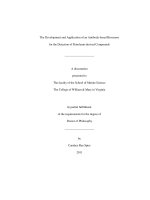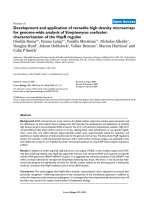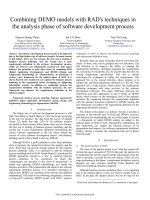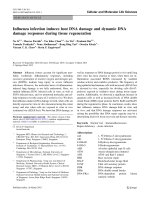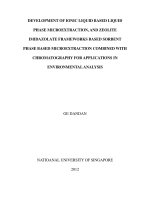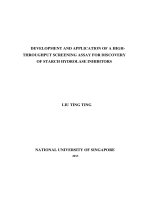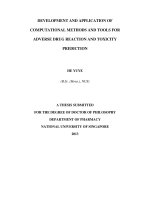Development and application of liquid phase microextraction techniques in the analysis of environmental pollutants
Bạn đang xem bản rút gọn của tài liệu. Xem và tải ngay bản đầy đủ của tài liệu tại đây (1.05 MB, 167 trang )
DEVELOPMENT AND APPLICATION OF
LIQUID-PHASE MICROEXTRACTION
TECHNIQUES IN THE ANALYSIS OF
ENVIRONMENTAL POLLUTANTS
by
HOU LI (M.Sc.)
A thesis submitted for the degree of
DOCTOR OF PHILOSOPHY
Department of Chemistry
National University of Singapore
2003
i
Acknowledgments
I would like to express my deepest gratitude to my supervisor Professor Lee
Hian Kee, for his invaluable guidance, encouragement and concern throughout
the entire project.
Special thanks go to Mdm Frances Lim for her technical assistance and help.
I would like to thank all of the research students in our laboratory, in particular
Ms Zhu Lingyan, Ms He Yi, Mr Gong Yinhan, Mr Tu Chuanhong, Ms Wen
Xiujuan, Ms Zhao Limian, Ms Sun Lei, Mr Zhu Liang, Mr Shen Gang, Mr Zhu
Xuerong and Mr Chanbasha Basheer for their assistance and friendship.
The financial assistance provided by the National University of Singapore
during my Ph.D. candidature is also greatly appreciated.
Finally, my deepest gratitude goes to my family for their unquestioning
support, understanding and encouragement.
ii
Summary
As an active research field in analytical chemistry, sample preparation
techniques is a key step in an analytical procedure and It has received increasing
attention in the past decade. Recently, with the trend of miniaturization and
automation, microscale sample preparation methods have begun to generate
strong interest and have undergone rapid development. These procedures are
environmentally friendlier, faster and easier to handle than conventional methods.
Normally, microscale sample preparation techniques include sorbent-based
and solvent-based microextraction. Sorbent-based microextraction is usually
termed solid phase microextraction (SPME). Solvent-based microextraction
which is also termed liquid-phase microextraction (LPME) features the use of
microlitres of organic solvent for the extraction and enrichment of analytes.
This work focuses on the development and application of two kinds of liquid-
phase microextraction techniques. One is drop-based solvent microextraction
including static liquid-phase microextraction (extraction solvent drop remains
static during extraction) and dynamic liquid-phase microextraction (extraction
solvent plug is agitated during extraction). Non-polar or lower polarity analytes
such as polycyclic aromatic hydrocarbons can be detected by both of the two
modes combined with HPLC. The parameters influential to extraction were
investigated, and the applicability of the methods to environmental water was
also evaluated.
Another microextraction approach involves the use of hollow fiber
combination with liquid-phase microextraction. It can be categorized into two-
iii
phase microextraction, and three-phase microextraction or liquid-liquid-liquid
microextraction (LLLME). By using hollow fiber membrane, the organic solvent is
held and protected by the membrane during the extraction process. Hence the
precision and stability of the methods are increased significantly. Also, sample
clean-up is possible by using this method because of the selectivity of the hollow
fiber so that it can be applied to “dirty” samples such as soil slurries and
biological fluids, etc. Hollow fiber protected dynamic two phase microextraction
has been developed and evaluated for the analysis of pesticides. Trace amounts
of pesticides have been determined from both water and soil, after extraction
using this procedure, by gas chromatography-mass spectrometry. Three-phase
hollow fiber microextraction is suitable for the extraction of polar and ionizable
analytes such as beta-blockers (drugs) and anilines (environmental pollutants)
etc. Static three-phase microextraction combined with on-line stacking has been
developed to extract and enrich several drugs prior to CE analysis. A novel
approach, named dynamic three-phase microextraction, has also been
developed and evaluated by using aniline compounds as the model analytes. In
comparison of dynamic three-phase microextraction with static three-phase
microextraction, the former provided higher extraction efficiency in a shorter time.
The results presented in this thesis show that all the liquid-phase
microextraction techniques can serve as excellent alternative methods to
conventional sample preparation techniques in the analysis of organic pollutants
or drugs in aqueous samples.
iv
List of abbreviations
SPME solid-phase microextraction
LPME
LPME/HF
LLLME
LLE
SPE
SME
USEPA
SFE
VOCs
LC
GC
FIE
CFME
PDMS
PA
PAHs
GC/MS
LC/MS
ECD
liquid-phase microextraction
liquid-phase microextraction with hollow fiber
liquid-liquid-liquid microextraction
liquid-liquid extraction
solid-phase extraction
solvent microextraction
United States Environmental Protection Agency
supercritical fluid extraction
volatile organic compounds
liquid chromatography
gas chromatography
flow injection extraction
continuous flow microextraction
polydimethylsiloxane
polyacrylate
polycyclic aromatic hydrocarbons
gas chromatography/mass spectrometry
liquid chromatography/ mass spectrometry
electron capture detection
v
CE
UV
PEEK
SME/BE
LPME/BE
HF
RSD
BLM
SLM
IS
LOD
OCPs
TCB
EF
SIM
OF
ASP
OP
3-NA
4-CA
4-BA
3,4-CA
PCBs
capillary electrophoresis
ultra violet
polyetheretherketone
solvent microextraction with simultaneous back extraction
liquid-phase microextraction with simultaneous back extraction
hollow fiber
relative standard deviation
bulk liquid membrane
supported liquid membrane
internal standard
limit of detection
organochlorine pesticides
trichlorobenzene
enrichment factor
selection ion monitoring
organic film
aqueous sample plug
organic phase
3-nitroaniline
4-chloroaniline
4-bromoaniline
3,4-dichloroaniline
polychlorinated biphenyls
vi
BSA
BTEX
OCPs
ppm
ppb
ppt
CITP
CGE
CIEF
CZE
MEKC
EOF
CEC
bovine serum albumin
benzene, toluene, ethylbenzene and o-xylene
organochlorine pesticides
parts per million
parts per billion
parts per trillion
capillary isotachophoresis
capillary gel electrophoresis
capillary isoelectrophoretic focusing
capillary zone electrophoresis
micellar electrokinetic chromatography
electroosmotic flow
capillary electrochromatography
vii
Contents
Chapter 1 Preface 1
1.1 Introduction 1
1.2 Sample preparation techniques 3
1.3 Sorbent-based microextraction 7
1.4 Solvent-based microextraction 9
1.4.1 Flow injection extraction (FIE) 10
1.4.2 Drop-based liquid-phase microextraction 11
1.4.2.1 LPME 11
1.4.2.2 LPME with simultaneous back-extraction 18
1.4.2.3 Theory of LPME 21
1.4.3 Hollow fiber-protected LPME 21
1.4.3.1 Two-phase hollow fiber-protected LPME 22
1.4.3.2 Three-phase hollow fiber-protected LPME 23
1.4.3.3 Theory of three-phase hollow fiber-protected LPME 27
1.5 Scope of study 28
Chapter 2 Drop-based liquid-phase micro-extraction technique combined with
HPLC analysis 30
2.1 Introduction 30
2.1.1 HPLC 30
2.1.2 Drop-based LPME 31
2.1.3 Polycyclic aromatic hydrocarbons (PAHs) 32
2.2 Experimental 33
2.2.1 Chemicals and samples 33
2.2.2 Silanization of glassware 34
2.2.3 Drop-based LPME procedures 35
2.2.3.1 Extraction of PAHs by static LPME 35
2.2.3.2 Extraction of PAHs by dynamic LPME 36
2.2.4 Apparatus 38
2.3 Results and discussion 38
2.3.1 Static LPME for trace analysis of PAHs in river water 38
2.3.1.1 Selection of extraction solvent 39
2.3.1.2 Selection of organic drop size 40
2.3.1.3 Speed of agitation 41
2.3.1.4 Selection of extraction time 43
2.3.1.5 Linearity, reproducibility and sensitivity 45
2.3.1.6 Extraction of PAHs in river water and tap water by static
LPME…………………… 47
2.3.2 Dynamic LPME in trace analysis of PAHs in drain water 49
2.3.2.1 Selection of extraction solvent 49
2.3.2.2 The volume of extraction solvent 50
2.3.2.3 Syringe plunger movement 51
2.3.2.4 Sampling volume 53
viii
2.3.2.5 Effect of salt on the extraction 54
2.3.2.6 Temperature 55
2.3.2.7 Linearity, reproducibility and sensitivity 57
2.3.2.8 Extraction of PAHs in drain water and tap water by dynamic
LPME …………………………………………………………………… 57
2.4 Conclusions and future research 60
Chapter 3 Two-phase hollow fiber-protected liquid-phase microextraction
technique combined with GC/MS 61
3.1 Introduction 61
3.1.1 Gas chromatography 61
3.1.2 Pesticides in aqueous samples 63
3.1.3 Extration of soil sample 65
3.2 Theory 66
3.2.1 Automated two-phase hollow fiber-protected dynamic LPME 66
3.2.2 Solid-phase microextraction 67
3.3 Experimental 68
3.3.1 Standards and reagents 68
3.3.2 Soil sample preparation 71
3.3.3 GC/MS analysis 71
3.3.4 Apparatus 73
3.3.5 Extraction procedures 74
3.3.5.1 Two-phase hollow fiber-protected dynamic LPME 74
3.3.5.2 Solid-phase microextraction 75
3.4 Results and discussion 76
3.4.1 Determination of pesticides in pond water and slurry sample by two-
phase hollow fiber-protected LPME 76
3.4.1.1 Selection of the organic solvent 76
3.4.1.2 Selection of the number of samplings (extraction cycles) 77
3.4.1.3 Selection of the movement pattern of plunger 78
3.4.1.4 Selection of the speed of agitation 82
3.4.1.5 Method evaluation 83
3.4.1.6 Analysis of pesticides in pond water and slurry samples 86
3.4.2 Determination of pesticides in soil by two-phase hollow fiber-
protected LPME and GC/MS 87
3.4.2.1 Selection of extraction solvent 87
3.4.2.2 Effect of extraction time 88
3.4.2.3 Effect of the movement pattern of the plunger on the extraction
90
3.4.2.4 Effect of the organic solvent content in aqueous soil samples
on LPME efficiency 91
3.4.2.5 Effect of humic acid concentration on LPME efficiency 92
3.4.2.6 Effect of salt concentration on LPME efficiency 93
3.4.2.7 Method evaluation 94
3.4.2.8 Extraction from aged soil sample 97
3.5 Conclusions and future research 99
ix
Chapter 4 Three-phase liquid-phase micro-extraction technique combined with
capillary electrophoresis 100
4.1 Introduction 100
4.1.1 General remarks of capillary electrophoresis 100
4.1.2 Basic principles of CE 101
4.1.3 Different modes of CE 102
4.1.4 Application of CE to the analysis of drugs and pollutants 103
4.1.5 Off-line and on-line concentration techniques for capillary
electrophoresis 103
4.1.6 Scope of project 105
4.1.6.1 Static three-phase LPME for aminoalcohols 106
4.1.6.2 Dynamic three-phase LPME 107
4.2 Experimental 108
4.2.1 Equipment 108
4.2.2 Chemicals and solvents 109
4.2.3 Materials 111
4.2.4 Extraction setup and procedures 111
4.3 Results and discussion 114
4.3.1 Preconcentration of aminoalcohols in urine by combined use of off-
column static three-phase LPME and on-column stacking for trace analysis
by CZE ………………………………………………………………………….114
4.3.1.1 Determination of aminoalcohols by CZE with off-column static
three-phase LPME 114
4.3.1.2 Determination of aminoalcohols by CZE with field-amplified
concentration 115
4.3.1.3 Determination of aminoalcohols by CZE with LPME-CE/FAC
117
4.3.1.4 Quantitative analysis 120
4.3.1.5 Human urine sample analysis 121
4.3.2 Preconcentration of anilines by dynamic three- phase LPME for
trace analysis by CZE 124
4.3.2.1 Mass transfer model 124
4.3.2.2 Basic principles 126
4.3.2.3 Optimization of dynamic three-phase LPME 128
4.3.2.4 Evaluation of dynamic three-phase LPME 135
4.4 Conclusions and future research 136
Chapter 5 Conclusions………………………………………………………………139
References 143
List of Publications 155
1
Chapter 1 Preface
1.1 Introduction
Analytical chemistry which is used to identify and measure quantities of
materials is a key to understanding nature. Currently, with the increasing concern
of environmental pollution by chemicals, environmental analysis has become an
even more important branch of analytical chemistry [1].
In the past decade, the presence of high/unacceptable concentrations of
organic substances in the aqueous environment has been a matter of increasing
interest to the water industry, scientists and the general public alike, from the
point of view of possible health hazards presented to both human and animal life.
It has been estimated that new chemicals, most of which are organic, are
invented and brought into use at a rate of over 1000 per year [2]. Many of these
will find their way into the aqueous environment as industrial by-products or
waste, such as plastics, detergents, solvents and pesticides etc. Even small
amounts of some pollutants can cause potentially toxic problems to man, animals
and fish. This has put pressure on regulating authorities and research
organizations to produce more information on trace levels of numerous
contaminants and their environmental significance. As a result, much analysis is
being carried out on all types of environmental samples. Probably, the most rapid
development in the analytical measurements of pollutants has taken place in the
quantification of organic pollutants.
Environmental analysis is different from other analysis in the analytical field
because environmental sample matrices are very complex and diversified. For
2
example, the matrix can be gaseous, aqueous and solid. Generally, the
concentrations of target compounds in environmental matrices are very low,
ranging from parts of million (ppm) to parts per billion (ppb), and even parts per
trillion (ppt) levels. There are several discrete steps in a modern analytical
process: field sampling, field sample handling, laboratory sample preparation,
separation and quantification, statistical evaluation, decision and finally action.
Each of these steps is critical for obtaining accurate and reliable results. It should
be noted that the slowest step determines the overall speed of the analytical
process. Due to characteristics of an environmental sample, the sample
preparation step is of extreme importance in the whole procedure, because it
must isolate the compounds of interest from the complex sample matrix that
cannot be handled by the analytical instrument directly, and bring the analytes to
a suitable concentration level for analysis. Furthermore, sample preparation can
include “clean up” procedures for very complex, “dirty” samples. For example,
before the amounts of trace pollutants present in soil or river water can be
determined, they must be isolated from the matrix, then preconcentrated, and
subjected to clean up [3].
The nature of environmental samples requires that the analytical technique
should be able to separate, detect and identify. In the past decades, most efforts
in the analytical field have been focused on the development of instruments to
speed up the analysis and increase the method sensitivity. However, during this
period of time, the development of sampling and sample preparation practices
were more or less neglected [4]. So far, most commonly used sample preparation
3
techniques, especially standard methods are still based on classical procedures
having a history of more than one hundred years, such as Soxhlet extraction [5].
These classical methods are usually time-consuming and tedious. Commonly,
while the actual instrumental analysis takes only several minutes, sample
preparation requires several hours or several days. Also, these classical sample
preparation methods have multi-step procedures, which lead to loss of
compounds, require the use of large amount of toxic solvents and potential for
error during the multi-transfer and operational procedures. Therefore, new
sample preparation methods which are less labor-intensive, afford less exposure
to potentially toxic chemicals and enhance productivity of data are needed [6,7].
1.2 Sample preparation techniques
Well-established methods of sample preparation, which have been used as
standard methods by the United States Environmental Protection Agency (EPA)
[8], include liquid-liquid extraction (LLE), supercritical fluid extraction (SFE),
purge and trap, headspace analysis, and solid-phase extraction (SPE).
LLE is the most time-consuming and requires large amounts of expensive
high purity organic solvents, which comprise the largest source of waste in an
environmental analysis laboratory [8]. The disadvantages of conventional
extraction techniques have led to the development of new methods which use
small volumes of organic solvent.
SFE is an attractive solvent-free sample preparation technique [9] because
the supercritical fluid integrates the advantages of both gas-like transfer and
4
liquid-like solvating characteristics. However, SFE requires an expensive, high-
pressure supercritical fluid (eg. supercritical carbon dioxide) delivery system.
Purge and trap is used for the analysis of volatile organic compounds (VOCs)
[10]. The extraction medium of this method is gaseous. The carrier gas is first
introduced into an aqueous sample to purge VOCs from the matrix. Then, the
VOCs are collected using a cold trap or sorbent trap. The disadvantages of this
extraction method include expensive operation, foaming and cross-
contamination.
Static headspace sampling is another technique for VOCs analysis [11]. The
extraction medium of this method is also in the gas-phase like purge and trap. It
has been used to analyze VOCs in food, clinical and other samples. Analytes are
equilibrated between the sample and its headspace. Because of the lack of any
concentrating effect, this technique suffers from low sensitivity.
In SPE [12,13], analytes are extracted together with interfering compounds by
passing an aqueous sample through a plastic cartridge or disk containing
sorbent. A selective organic solvent is normally used to remove interferences
first, and then another solvent is chosen to wash out the target analytes. SPE is
simple, inexpensive and uses relatively little solvent although this is still in the
milliliter range. However, it does have some limitations such as low recovery and
blockage of the pores in the sorbent by solid or oily components.
On the basis of the above limitations, there appears to be a great need for
new approaches to sample preparation methods which have good efficiency,
selectivity, are easy to use, inexpensive and compatible with a wide range of
5
analytical instruments. In this respect, miniaturization has become an important
trend in the development of sample preparation techniques [14]. Microextraction
technique, like any other sample preparation methods, is also based on the
partition of analytes between the sample matrix and an extracting phase. The
basic principle of microextraction is to employ microliter volumes of extracting
phase selectively to extract or enrich target compounds from the bulk sample
matrix. In the past few years, microscale sample preparation techniques have
undergone dramatic development though they are still in their infancy. Generally,
microscale sample preparation techniques are simpler, faster and more
environmentally attractive than conventional ones. Based on the extracting
phase, microextraction methods currently can be classified into sorbent-based
microextraction and solvent-based microextraction, as shown in Figure 1-1.
6
Figure 1-1 Classification of microextraction methods. (For explanation of abbreviations, refer to page IV to VI)
7
1.3 Sorbent-based microextraction
The concept of using a sorbent material to extract trace organic compounds
from various sample matrices was developed twenty years ago [15, 16]. A
sorbent with strong affinity toward organic compounds has the ability to retain
and concentrate those compounds from a very dilute aqueous or gaseous
sample.
SPE is a well-established sorbent-based macro-extraction method and has
been applied to many fields such as environmental, clinical and biology analysis
[17]. However, SPE still uses appreciable amounts of toxic solvents. The concept
of SPME which can eliminate this drawback of SPE was developed in 1989 by
Belardi and Pawliszyn [18]. As a microextraction method, SPME is very easy to
operate, fast and is completely solvent-free [19]. Following its rapid development,
the first SPME device fiber-like holder was introduced in 1990 [20] and the SPME
device based on a reusable microsyringe was commercialized in 1993 by
Supelco, together with the coated fibers used for extraction. Today, the types of
coated fibers have included polydimethysiloxane (PDMS), polyacrylate (PA),
Carbowax-divinylbenzene, PDMS-divinylbenzene and Carboxen-PDMS.
To date, SPME has been developed swiftly in theory, technology and
application. In the past decade, more than 400 articles on SPME have been
published in different fields which include environmental, food, pharmaceutical,
biological, toxicological and forensic applications, as well as its theoretical
aspects [21]. SPME features the use of micro-litre volumes (less than 1 µl) of
extracting phase coated evenly on a supporting material to concentrate analytes
8
from the sample matrix or headspace. It is an effective adsorption and desorption
technique, which eliminates the need for solvents or complicated apparatus.
Currently, SPME can be classified into on-fiber SPME [20] and in-tube SPME
[22]. The main difference between them is that the extracting phase is coated on
a tiny supporting rod for on-fiber SPME and the inner surface of a short capillary
column is coated by the extracting phase for in-tube SPME. So far, on-fiber
SPME is the most popular one in the field of microextraction methodology [23-
31]. Generally, on-fiber SPME is combined with GC analysis and also can be
accommodated in a modified HPLC injector for analysis. In spite of the popularity
of on-fiber SPME, in-tube SPME is another important concept because it offers a
range of extracting phases and the potential of automation and combination with
HPLC and CE [32, 33]. Generally, SPME can provide good quantitative results
over wide ranging concentrations of analytes and is sensitive for low-
concentration analytes. However, there are some limitations in the technique.
Firstly, it suffers from sample carry-over, which may be difficult to eliminate in
some cases, though fibers are normally reconditional at high temperatures. Thus,
blank GC or LC runs should be performed with the fiber between extractions.
Secondly, the quality of the fibers depends on the manufacturer, and
sometimes the performance is different from batch to batch. Conditioning should
always be performed on each new fiber and also when a fiber has not been used
for some time. However, even with careful conditioning of the fiber, some
bleeding of the stationary phase is observed.
9
Another problem is that the fibers of SPME are very fragile and can easily be
broken. When applied to “dirty samples”, the fiber coating can be damaged by
the high percentage of suspended matter during agitation; also, high-molecular-
mass compounds can adsorb irreversibly to the fiber, thus changing the
properties of the coating and rendering it unusable subsequently.
The problem mentioned above might be one of the reasons for the poor
reproducibility and linearity sometimes encountered with SPME, although using
headspace SPME or adding internal standard can circumvent these problems.
However, the analytes which can be concentrated by headspace SPME are
limited, and it is rather expensive and difficult to find suitable isotopically labeled
internal standards to obviate this difficulty .
1.4 Solvent-based microextraction
The concept of solvent microextraction (SME) can be traced back to the
middle of the 1970s, when there were attempts to address the problems of high
solvent consumption and poor automation in LLE. In LLE, the phase ratio is one
of the critical parameters having great influence on extraction efficiency. A small
amount of organic solvent was used to extract analytes from a large amount of
aqueous sample to increase the phase ratio between the two phases [34]. In
1975 [33], a simple liquid extraction method based on the use of about 1 ml of
organic solvent was reported. Subsequently, based on this liquid extraction
method, Murray et al. [35] described a method termed as solvent microextraction.
Several hundred microliters of solvent was used to extract from about 1 liter of
water sample. The semi-quantitative result could be improved with the possibility
10
of injecting larger sample volumes (20-80 µl) into a GC system to increase the
amount of sample and therefore method sensitivity [36, 37]. There is a similar
solvent microextraction method in EPA standard methodologies [8] to analyze
organochlorine pesticides and commercial polychlorinated biphenyl (PCBs) in
water. In the 1980s [38, 39], the main development of solvent microextraction
was flow injection extraction (FIE). FIE has the advantages of high speed, low
cost and reduced solvent/sample consumption. However, the solvent
consumption in FIE is still in the order of several hundred microliters per analysis
and there are problems of deposition and adsorption of the particles on the
optical cell windows during analysis.
In recent years, efforts have been placed on miniaturizing solvent extraction
processes. Two general methods have evolved including drop-based solvent
microextraction and hollow fiber combined with solvent microextraction. The
methods developed are interesting alternatives to conventional LLE [40, 41]. In
the former method, the extraction phase is a discrete drop of immiscible solvent
suspended in an aqueous sample or its headspace. In the latter method,
microliters of extracting solvent are confined in a porous hollow fiber which is in
contact with the sample.
1.4.1 Flow injection extraction (FIE)
Flow injection extraction (FIE) was first described in 1978 independently by
Karlberg and Thelander [42] and by Bergamin et al. [43]. In FIE [44], a liquid
sample is injected as a plug into a carrier stream which is often air segmented to
minimize broadening of the sample plug. After the segmented stream passes
11
through the coil, the organic phase is separated from the aqueous phase and led
through a flow cell. The injected sample forms a zone, which is then transported
toward a detector that continuously records the absorbance, electrode potential,
or other physical parameters as the zone continuously flows due to the passage
of the sample material through the flow cell. Both segmentation and phase
separation are critical aspects of the FIE technique with respect to reliability and
precision.
1.4.2 Drop-based liquid-phase microextraction
Drop-based solvent microextraction or liquid-phase microextraction (LPME)
has been receiving attention in recent years. It focuses on miniaturizing the
solvent extraction procedure. The feature of methods based on this extraction
approach is that only a very small amount of extracting solvent is used. As phase
ratios (organic solvent: aqueous phase) are reduced, LPME developed are
equilibrium extraction techniques rather than exhaustive extraction techniques
such as LLE.
1.4.2.1 LPME
In 1996, Liu and Dasgupta reported a novel drop-in-drop extraction system
[45]. A water-immiscible organic microdrop (~1.3 µl) was suspended inside a
flowing larger aqueous drop from which the analyte was extracted. Figure 1-2
shows the drop-in-drop system. The aqueous phase of the outer drop contained
the analyte of interest and was continuously delivered and aspirated away
throughout the sampling. The analytical response of the instrument was linearly
12
related to the analyte concentration and precision (5.0%) was assumed to be
affected by the organic drop volume variation during the determination process.
While the kinetics of the process were not described in detail, the importance of
convective transport of analyte was highlighted. The advantages of the drop-in-
drop system include low consumption of organic solvent and the facility of
automatic backwash between aqueous and organic drops.
Figure 1-2 Schematic diagram of the drop-in-drop system
Also in 1996, another drop-based solvent microextraction was developed by
Jeannot and Cantwell [46]. A microdrop (8 µl) of water-immiscible organic
solvent, containing a fixed amount of internal standard, was left at the end of a
Teflon rod immersed in a stirred aqueous sample solution. Figure 1-3 shows a
side view illustration of the single-drop microextraction system. After the solution
13
had been stirred for a prescribed period of time, the rod was removed from the
sample solution, and the organic drop was sampled with a microsyringe and
injected into a GC instrument for further analysis. Essential information regarding
equilibrium and kinetics of the process was also given. The mass transfer
coefficient was tentatively interpreted in overall terms of the film theory. However,
one drawback of both drop-in-drop system and the single-drop microextraction
system is that extraction and injection was performed separately in two different
devices. For the latter procedure, the use of a Teflon rod was not very
convenient.
Figure 1-3 Side view illustration of the solvent microextraction system (approximately to scale).
Magnetic stirrer not shown.
14
In 1997, an alternative drop-based extraction technique [47] was introduced.
In this revised protocol, a single drop (1 µl) of organic solvent was suspended on
the tip of a conventional microsyringe needle and was immersed in a stirred
sample solution. After extraction for a certain time, the solvent drop was retracted
back into the microsyringe and was directly injected into the GC for analysis. The
authors found that mass transfer in this microextraction system was proportional
to diffusion coefficients. Thus, the film theory of convective-diffusive mass
transfer is applicable here rather than penetration theory where a square-root
relationship is required
Later, the same research group extended the above drop-based technique to
extract free progesterone in a protein solution [48]. In the presence of 1% (w/v)
bovine serum albumin (BSA), the extraction rate of analyte was increased, thus
the processes of diffusion, adsorption and desorption of analyte to the protein film
formed at the liquid-liquid interface were assumed to enhance mass transfer of
analyte.
He and Lee introduced the term liquid-phase microextraction (LPME) [40] in
1997. They investigated two different modes of LPME by extracting of 1,2,3-
trichlorobenzene from aqueous solution combined with capillary GC analysis.
Both modes, i.e., static LPME and dynamic LPME, involved the use of very small
amounts of organic solvent (<2 µl). In static LPME, the organic drop suspended
on the needle tip of microsyringe was immersed to the stirred aqueous sample
solution, while mass transfer of analytes from aqueous sample to organic drop
occurred through the effect of diffusion. In dynamic LPME, the microsyringe was
15
used as a micro-separatory funnel as well the sample introduction device for
injection into a GC for analysis. Dynamic LPME features the repeated movement
of the syringe plunger, as compared to static LPME. There are two features that
should be noted in dynamic LPME. Firstly, a very thin organic film is left and
formed on the inner surface of the microsyringe barrel and needle after the
organic solvent is withdrawn [40], followed by the aqueous sample solution.
Extraction then takes place between the organic film (OF) and aqueous sample
plug (ASP). In addition, a small percentage of analyte in the ASP is transferred
directly to the solvent plug located at the syringe plunger. Secondly, the repeated
aspiration of the ASP, following the first sampling cycle, ensures that both the OF
and the ASP are periodically renewed, and thus the OF would be in contact with
fresh aqueous sample having the initial analyte concentration in the sample vial.
Later, the same research group applied static mode of LPME to the analysis of
eight organochlorine pesticides in water [49]. Factors relevant to the extraction
process were investigated. The sensitivity of the method was enhanced with
agitation, and increasing the extraction temperature, of the sample solution. On
the other hand, the dynamic LPME work was extended to the analysis of ten
chlorobenzenes with GC analysis [50]. The role of some important factors that
influence the extraction efficiency was determined. Good linearity, sensitivity,
repeatabilities, and relative recoveries were obtained, thus demonstrating the
applicability of this method to trace analysis. Both static LPME and dynamic
LPME were also applied to the determination of polycyclic aromatic hydrocarbons
combined with HPLC analysis [51].
